If you’re a plant enthusiast, chances are you’ve come across the charming trailing vines of pothos, also known as Epipremnum aureum. With so many shapes and forms available, it can be tough to keep track of them all, which is the reason why we’ve decided to explore the fascinating world of pothos varieties.
Due to their hardy nature, pothos make a great choice for those new to indoor gardening. But beyond their resilience, they also come in a decent range of stunning foliage, from spotted or highly variegated leaves to crinkled and unusual shapes. In a nutshell, each variety has its unique charm.
So if you’re wondering what kind of pothos you have or just looking to expand your collection with some cool and uncommon cultivars, we’ve got you covered!
Table of Contents
1. Golden Pothos, Devil’s Ivy (Epipremnum aureum)

The Golden Pothos is a stunning houseplant that is almost foolproof to grow indoors. Its heart-shaped leaves are a beautiful mid-green color, highlighted with creamy gold splashes, making them a joy to admire. The plant is a tropical vine that has adapted well as a hardy houseplant, and it comes in a variety of natural and cultivated forms, each with its unique foliage patterns, but you’ll have to read on to find more about these!
And there’s more! This “classic” pothos can climb, cling and trail around anything in its path, spreading and sliding towards sources of light.
2. Marble Queen Pothos (Epipremnum aureum ‘Marble Queen’)
The Marble Queen Pothos comes with moss-green leaves and stems that are beautifully streaked with white. This variegated foliage makes it a unique and attractive choice for indoor spaces, but it requires more light than other pothos varieties to keep its variegation bright.
Compared to the Golden Pothos, the Marble Queen has more prominent white/cream variegation, making it easily distinguishable. The growth of the Marble Queen Pothos is slower due to less chlorophyll in each leaf, which is typical of highly variegated plants.
To promote healthy growth, the Marble Queen Pothos should be placed in a location with medium to bright indirect light, and away from areas that are too dark.
3. Jessenia Pothos (Epipremnum aureum ‘Jessenia’)
Jessenia Pothos stands out due to its highly variegated appearance. It has light green, heart-shaped leaves with chartreuse highlights and is a stable sport of the more common Marble Queen Pothos. However, unlike Marble Queen, Jessenia comes with darker and lime-green leaves. It should also be noted that each leaf is unique, adding to the plant’s visual appeal.
Developed by Costa Farms in 2014, Jessenia Pothos is a great addition to any indoor garden and a perfect choice for plant lovers who want a low-maintenance yet unique variety.
4. Pearls and Jade Pothos (Epipremnum aureum ‘Pearls and Jade’)
Pearls and Jade Pothos is a patented variety developed at the University of Florida. It features green leaves that are adorned with a striking variegation of silver-gray and white tones. The variegation, however, tends to occur more on the edges of the leaves, rather than the center, which sets it apart from other pothos varieties.
Furthermore, the whiter parts of the foliage on this plant are often marbled with green and silver-gray hues, enhancing its stunning appearance. When compared to other pothos varieties, Pearls and Jade feature smaller, slower-growing leaves. Its foliage is thinner than that of the Marble Queen pothos, which is the cultivar that this patented sport was derived from.
5. N’Joy Pothos (Epipremnum aureum ‘N’Joy’)

The N’Joy Pothos is a newer variety of pothos that features distinctive heavily variegated, light green leaves that are flecked with white. While it may be confused with Pearls & Jade Pothos, it lacks the small splashes of green on its leaves, making it a distinct type.
Compared to other varieties such as Golden Pothos, this one is a slow grower, and it can take up to three years to grow six feet long. However, growing N’Joy Pothos is easy as it can thrive in any well-lit area of your home.
Note: To differentiate it from other pothos varieties, look for its white variegation without any green splashes.
6. Glacier Pothos (Epipremnum aureum ‘Glacier’)
The Glacier Pothos is another sought-after variety of pothos, prized for its stunning green and white coloring. Unlike its close relatives, the N’joy and Pearls and Jade pothos, this one has a distinct silvery-green color and more oval-shaped leaves. It is also considered rarer and harder to come by.
7. Neon Pothos (Epipremnum aureum ‘Neon’)
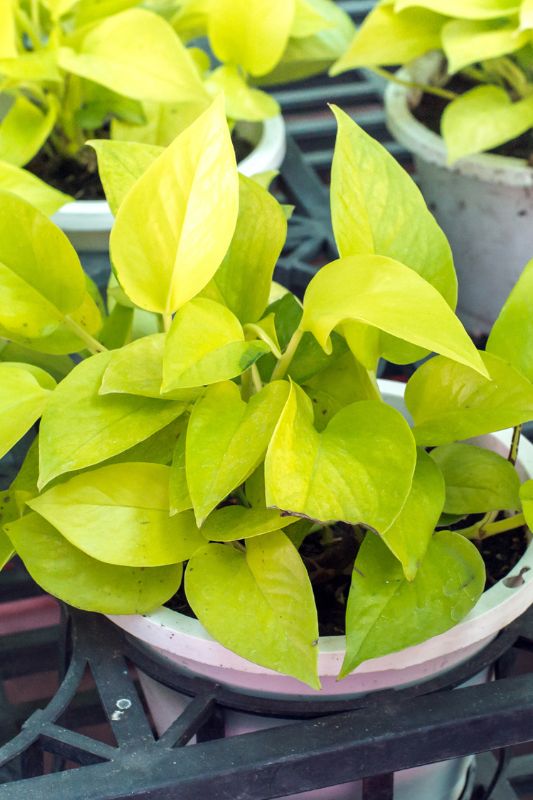
Neon Pothos is known for its heart-shaped leaves that come with a distinct neon glow. The younger leaves are especially vibrant and have a more intense color than the older ones (mature leaves will deepen in color).
However, to maintain its distinctive color, it is best to grow it in bright light, as low light conditions can make the leaves appear dull and washed out.
And because there’s usually a bit of confusion when it comes to philodendrons and pothos, this variety is also often mistaken for the lemon-lime philodendron, but its coloring is slightly different.
8. Snow Queen Pothos (Epipremnum aureum ‘Snow Queen’)
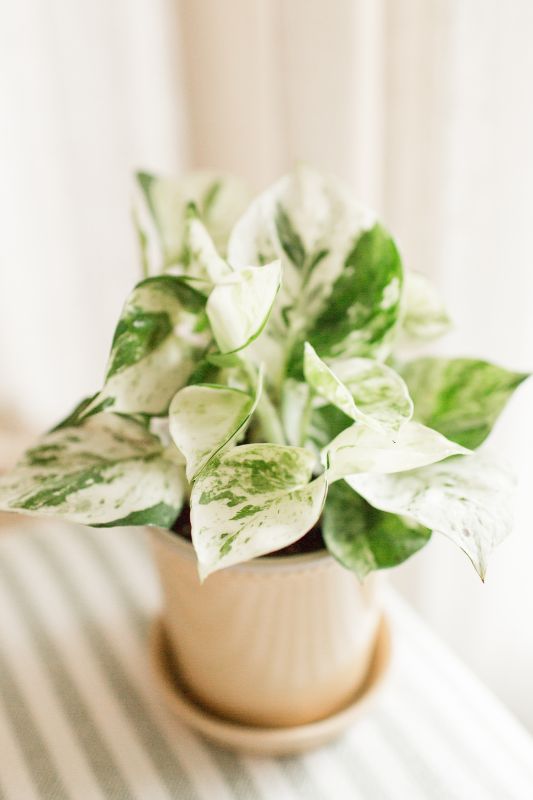
The Snow Queen Pothos is a unique variety of pothos that features white and green leaves with a predominantly white color and sporadic green spots. Its highly variegated leaves lack chlorophyll, making it grow more slowly than green-leafed pothos, which is why it requires a location with bright, indirect light to prevent the leaves from reverting (reverse variegation).
Compared to the Marble Queen Pothos, which has a similar appearance, the Snow Queen variety boasts more consistent and extensive white variegation, giving it its name. The white/cream foliage is decorated with thin streaks of medium green variegation, making it a real stunner. Its unique appearance sets it apart from other varieties of pothos, making it an excellent choice for those looking for something different to add to their collection.
9. Manjula Pothos (Epipremnum aureum ‘Manjula’)
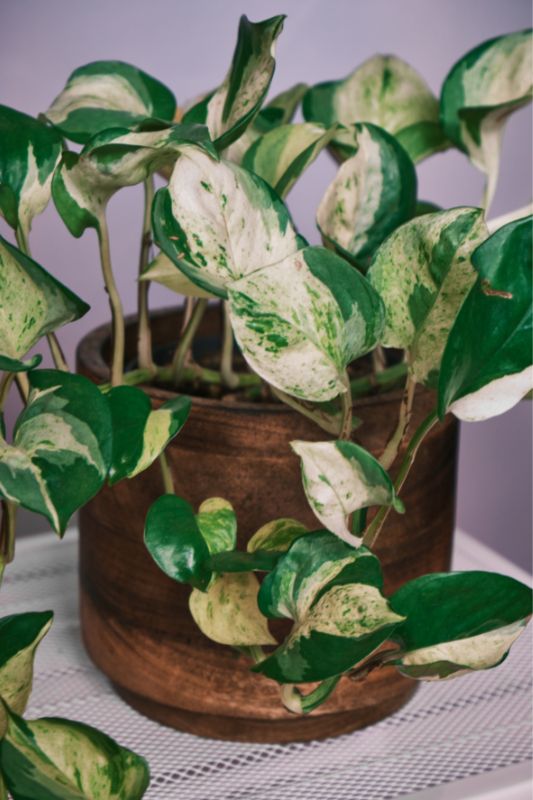
This one is a patented variety of pothos developed by the University of Florida. Its leaves feature curvy edges with cream, silver, white, and green variegation, making for an interesting and fun plant to grow.
The shape of Manjula Pothos leaves is wider and rounder compared to the very similar Marble Queen variety. The color variation among the leaves is also quite diverse, with some having large green patches while others have freckles and other colors. In addition to its unique appearance, Manjula Pothos can thrive in low light conditions but prefers bright, indirect light.
Being a rare and sought-after variety of philodendron, Manjula might not be the best investment for beginner gardeners.
10. Harlequin Pothos (Epipremnum aureum ‘Harlequin’)
Harlequin Pothos is believed to be a highly variegated cultivar of Manjula, some people suggest that it is a separate variety. Its leaves have a beautiful, contrasting appearance due to the abundance of white and dark green foliage.
Unlike Manjula, Harlequin does not have any cream or yellow coloring. Its white variegation is so intense that propagating this plant can be challenging. Bright, indirect light is crucial for Harlequin Pothos to maintain its striking variegation.
Although Harlequin is considered one of the rarest and most uncommon Pothos varieties, we didn’t manage to find enough information on its origin and classification.
11. Sleeping Pothos (Epipremnum aureum ‘Shangri La’)
The Sleeping Pothos is another unique variety. However, unlike most pothos types out there, this one comes with curled, crinkled leaves that give it a shriveled appearance, resembling closed eyes (or cooked spinach).
Despite being an acquired taste in looks, this rare and expensive plant is becoming popular among houseplant enthusiasts. It requires simple maintenance, is resistant to pests and diseases, and can become a statement piece in any home.
12. Global Green Pothos (Epipremnum aureum ‘Global Green’)
The leaves of Global Green Pothos are mottled with dark and light green in a way that gives them a marbled effect. While the distribution of coloring on the leaves is similar to the N’joy or Pearl and Jade pothos, its distinct features is the way the mid-green leaves have darker green edges, creating a ruffled or crumpled appearance.
Occasionally, you might also see small slivers or patches of cream or white on this variety. Also, thanks to all the chlorophyll in the leaves, the Global Green variety is a quick grower compared to more highly variegated varieties.
While still considered rare, this pothos is becoming more widely available at garden centers and nurseries due to its growing popularity.
13. Jade Pothos (Epipremnum aureum ‘Jade’)
One of the oldest and most common varieties out there, the Jade Pothos is distinguished by its solid jade-green foliage, which is thicker and shinier than other varieties.
It can grow up to 30 feet in length, and is a great option for those who have limited natural light, as it can adapt to a variety of lighting conditions, from low light to bright, indirect light. Even so, it’s best to keep it at or below 6-10 feet to maintain its appearance.
14. Hawaiian Pothos (Epipremnum aureum ‘Hawaiian’)
The Hawaiian Pothos stands out from its more common cousin, the Golden Pothos. While both plants have similar growth habits, the Hawaiian variety has larger leaves that can grow up to 12 inches long. When it comes to variegation, this one also has distinct multicolored bright green leaves overlaid with brilliant streaks of gold.
While it may look similar to the Golden Pothos, it is still a rare and unique variety that can prove a bit difficult to find.
Frequently asked questions
Pothos and Scindapsus are often confused as being the same plant, but they are actually two different species. Pothos belongs to the Epipremnum genus, while Scindapsus belongs to the Scindapsus genus. Both plants are in the family Araceae and have similar appearances, but they have some distinguishing characteristics, such as leaf shape and growth habits.
Epipremnum pinnatum is sometimes referred to as “dragon tail” or “silver vine,” but it is not considered a Pothos plant. However, like Pothos, it is a member of the Araceae family and is often grown as a houseplant due to its easy care and attractive foliage.
Pothos and Philodendron are two different plants, although they are often confused because they look similar. One major difference between them is that Pothos has larger, heart-shaped leaves, while Philodendron has leaves that are typically smaller and more elongated. Additionally, Pothos has a trailing growth habit and is often grown as a hanging plant, while Philodendron can be either a trailing or upright plant and is typically grown for its foliage.
Yes, Pothos plants can be grown in water. In fact, they are one of the easiest plants to propagate in water. Simply cut a section of stem with a few leaves and place it in a jar or vase filled with water. Change the water every few days and wait for roots to form, then transplant the cutting into soil.
Yes, Pothos plants are toxic to pets, including dogs and cats. The plant contains calcium oxalate crystals that can cause irritation and swelling in the mouth, tongue, and throat. Ingestion can also cause digestive upset, including vomiting and diarrhea. If you have pets, it’s best to keep Pothos plants out of their reach.

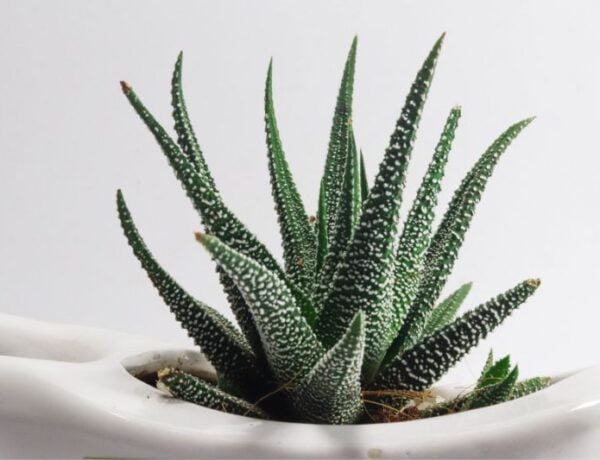

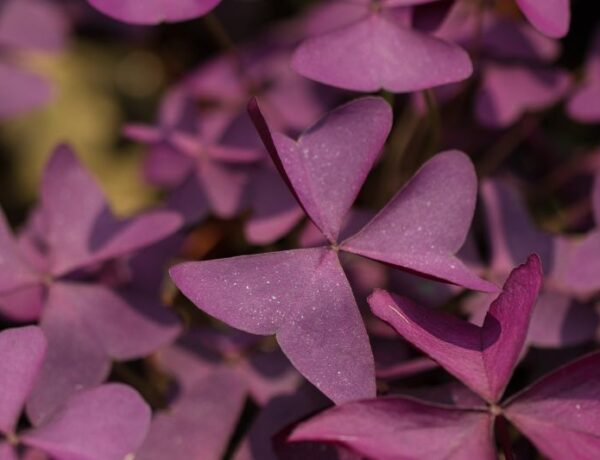


No Comments